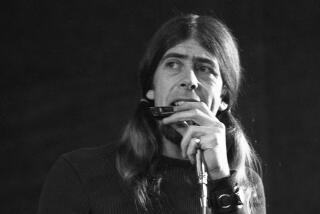THE BIRTH OF BEBOP: A Social and Musical History.<i> By Scott DeVeaux</i> .<i> University of California Press: 574 pp., $35</i>
- Share via
Bebop, a form of jazz that emerged midway in the music’s century-long history, is today the dominant influence on how jazz is played and taught. When bebop first appeared, it was correctly perceived as avant-garde, yet it quickly became part of jazz’s mainstream, commercially viable and accepted, at least partially, by American pop culture. No cutting-edge art has since matched that triumph.
Scott DeVeaux seeks to explain bebop by exploring its emergence. His book offers a historical account and a sociological analysis as well as the author’s learned musician’s perspective. All previous theories about the origins and rise of bebop are touched upon by DeVeaux, for instance, the view that bebop was a rebellion by spirited jazz improvisers against the Swing Era’s big bands with their encumbering arrangements, which made jazz a largely written music. Zipping through the many theses and antitheses, DeVeaux, an associate professor of music at the University of Virginia and a pianist, singer and percussionist, offers his synthesis, a complex one.
Coleman “Bean” Hawkins, the great tenor saxophonist, a pioneer whose preeminence continued as jazz changed, is the essential character in “The Birth of Bebop.” Hawkins’ approach to music was quite different from most of his contemporaries. He had left the United States in 1934, at the dawn of the Swing Era, to tour Europe as a solo artist, returning five years later as World War II loomed. DeVeaux senses that upon his return, Hawkins was dissatisfied with the directions jazz had taken--not just the emphasis on big bands but also an absence of growth in the jazz musician’s basic harmonic knowledge. Hawkins was intrigued, even thrilled, by the experiments a handful of younger players were incorporating into their improvisations. He eventually decided to cast his lot with them. An established jazz star, Hawkins accelerated the process by which their music, called bebop, could be heard. He helped the music mature and enabled bebop to gain its ensemble context. He also composed repertoire: essentially building blocks for bebop’s progression into a genuine jazz music. A professional, Hawkins examined the scene and found a way for bebop to work economically, demonstrating to his young charges how it could be done.
The nuance and complexity of DeVeaux’s bebop portrait lie in combining his feeling about Hawkins’ dominance with insightful passages on, among others, the genius of Dizzy Gillespie and Charlie Parker, the duo credited in most accounts with the creation of bebop. This juggling act is made more difficult by the jazz musician in DeVeaux, who can’t help point out that the great Coleman Hawkins was not always comfortable playing bebop and that many of his recorded performances lack the assurance of his younger associates. DeVeaux’s bebop guide also becomes quite involved as it follows its key figures’ career moves, both independent and in tandem, as they performed in the volatile scene that was the jazz entertainment industry during World War II. Nevertheless, negotiating this difficult terrain, DeVeaux has written a useful, at times fascinating, account and accounting for the extraordinary American music that is bebop.
More to Read
The biggest entertainment stories
Get our big stories about Hollywood, film, television, music, arts, culture and more right in your inbox as soon as they publish.
You may occasionally receive promotional content from the Los Angeles Times.









